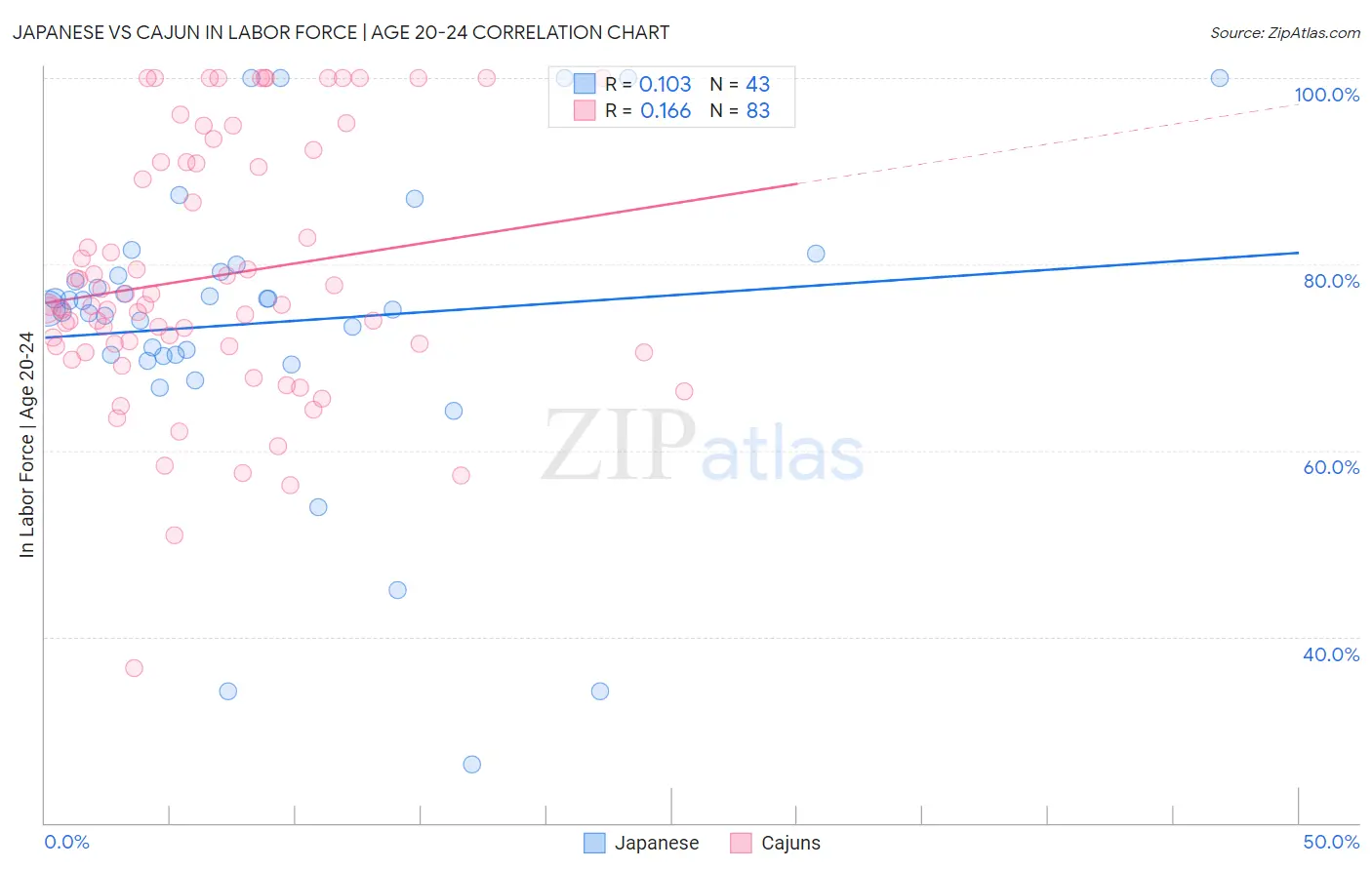Japanese vs Cajun In Labor Force | Age 20-24
COMPARE
Japanese
Cajun
In Labor Force | Age 20-24
In Labor Force | Age 20-24 Comparison
Japanese
Cajuns
75.3%
IN LABOR FORCE | AGE 20-24
68.7/ 100
METRIC RATING
160th/ 347
METRIC RANK
75.1%
IN LABOR FORCE | AGE 20-24
51.1/ 100
METRIC RATING
171st/ 347
METRIC RANK
Japanese vs Cajun In Labor Force | Age 20-24 Correlation Chart
The statistical analysis conducted on geographies consisting of 249,162,424 people shows a poor positive correlation between the proportion of Japanese and labor force participation rate among population between the ages 20 and 24 in the United States with a correlation coefficient (R) of 0.103 and weighted average of 75.3%. Similarly, the statistical analysis conducted on geographies consisting of 149,676,462 people shows a poor positive correlation between the proportion of Cajuns and labor force participation rate among population between the ages 20 and 24 in the United States with a correlation coefficient (R) of 0.166 and weighted average of 75.1%, a difference of 0.27%.

In Labor Force | Age 20-24 Correlation Summary
| Measurement | Japanese | Cajun |
| Minimum | 26.3% | 36.6% |
| Maximum | 100.0% | 100.0% |
| Range | 73.7% | 63.4% |
| Mean | 73.7% | 78.7% |
| Median | 75.3% | 75.5% |
| Interquartile 25% (IQ1) | 70.1% | 71.2% |
| Interquartile 75% (IQ3) | 79.2% | 90.9% |
| Interquartile Range (IQR) | 9.1% | 19.7% |
| Standard Deviation (Sample) | 16.2% | 13.7% |
| Standard Deviation (Population) | 16.0% | 13.7% |
Demographics Similar to Japanese and Cajuns by In Labor Force | Age 20-24
In terms of in labor force | age 20-24, the demographic groups most similar to Japanese are South American Indian (75.3%, a difference of 0.010%), Immigrants from Bolivia (75.3%, a difference of 0.040%), Immigrants from El Salvador (75.3%, a difference of 0.050%), Immigrants from Western Europe (75.3%, a difference of 0.050%), and New Zealander (75.2%, a difference of 0.050%). Similarly, the demographic groups most similar to Cajuns are Mexican (75.1%, a difference of 0.010%), Yakama (75.1%, a difference of 0.010%), Immigrants from Croatia (75.1%, a difference of 0.010%), South African (75.0%, a difference of 0.020%), and Syrian (75.0%, a difference of 0.020%).
| Demographics | Rating | Rank | In Labor Force | Age 20-24 |
| Immigrants | Guatemala | 71.9 /100 | #155 | Good 75.3% |
| Immigrants | El Salvador | 71.7 /100 | #156 | Good 75.3% |
| Immigrants | Western Europe | 71.5 /100 | #157 | Good 75.3% |
| Immigrants | Bolivia | 71.0 /100 | #158 | Good 75.3% |
| South American Indians | 69.0 /100 | #159 | Good 75.3% |
| Japanese | 68.7 /100 | #160 | Good 75.3% |
| New Zealanders | 65.4 /100 | #161 | Good 75.2% |
| Immigrants | Romania | 64.6 /100 | #162 | Good 75.2% |
| Costa Ricans | 64.2 /100 | #163 | Good 75.2% |
| Bolivians | 64.0 /100 | #164 | Good 75.2% |
| Afghans | 63.5 /100 | #165 | Good 75.2% |
| Cambodians | 60.5 /100 | #166 | Good 75.2% |
| Immigrants | South Eastern Asia | 57.5 /100 | #167 | Average 75.1% |
| Immigrants | Western Africa | 56.7 /100 | #168 | Average 75.1% |
| Immigrants | Philippines | 55.8 /100 | #169 | Average 75.1% |
| Mexicans | 52.1 /100 | #170 | Average 75.1% |
| Cajuns | 51.1 /100 | #171 | Average 75.1% |
| Yakama | 50.8 /100 | #172 | Average 75.1% |
| Immigrants | Croatia | 50.2 /100 | #173 | Average 75.1% |
| South Africans | 50.0 /100 | #174 | Average 75.0% |
| Syrians | 49.5 /100 | #175 | Average 75.0% |